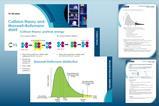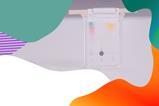Displacement reactions can be used to determine the relative reactivity of the halogen elements
This microscale experiment shows the reactions between chlorine, bromine and iodine ions with potassium chloride, potassium bromide and potassium iodide respectively. You will see a colour change where a reaction has occurred. The reactivity trend of these three halogens can be deduced from the reactions that take place.
Chapter titles: 00:10 Introduction; 01:25 Set up for microscale experiment; 04:59 Illustration of displacement reaction; 05:54 Redox reactions; 06:34 Results table.
Download additional resources
Supporting resources booklet including pause-and-think questions with answers, teacher notes, intended outcomes, follow-up worksheets and structure strips. Plus technician notes and integrated instructions. Editable versions of all worksheets and key resources are provided.
Teacher notes
Full teacher notes are available in the supporting resources booklet, including ideas for how to use this video and the supporting resources as part of your teaching.
Notes on running the practical experiment
Technician notes and integrated instructions are available to support this practical.
The microscale displacement of halogens reaction takes around 10 minutes and it is safe for learners to work in pairs.
TIP Once completed learners can take a photo of their results using a mobile phone or tablet, so that they can clear away immediately. This will help avoid learners spilling chemicals on their results table.
Procedure for the displacement of halogens
- Take a dimple tray and label the rows, Cl2, Br2, I2 and the columns H2O, KCl, KBr, KI either using a non-permanent marker pen or by placing the dimple tray on top of a piece of paper. Alternatively this experiment could be carried out on a laminated copy of the integrated instructions.
- Using the dropper bottle add 3–4 drops of the chlorine water to each dimple in the first row.
- Using the dropper bottle add 3–4 drops of the bromine water to each dimple in the second row.
- Using the dropper bottle add 3–4 drops of the iodine solution to each dimple in the third row.
- Note down the colours of each solution.
- Add 3–4 drops of distilled water to each dimple in column 1.
- Add 3–4 drops of potassium chloride solution to each of the three dimples in column 2 of the tile.
- Add 3–4 drops of potassium bromide solution to each of the three dimples in column 3 of the tile.
- Add 3–4 drops of potassium iodide solution to each of the three dimples in column 4 of the tile
- Observe and record any colour changes that take place in each row by comparing the first dimple with the others in the row.
Real-world context
Show learners this animation from the international bromine industry that reveals how bromine is produced from seawater.
Further practical activities
If you would like to explore the halogens further, find details of the following two experiments:
- the halogens in water and a hydrocarbon solvent
- acidic and bleaching properties of the halogens
Key terms
Learners will need to have a clear understanding of the following scientific terminology:
Displacement – a type of chemical reaction where part of one reactant is replaced with another reactant. The displacement reactions occurring in this practical are single displacement reactions and take the form: AB + C → AC + B
Reactivity – a measure of how readily a substance undergoes a chemical reaction.
Metal halide – general term used to describe the group of ionic compounds that form when a metal reacts with a halogen.
Ionic compound – a compound made up of oppositely charged ions. Ionic compounds are held together by strong electrostatic forces between oppositely charged ions. These forces are called ionic bonds.
We have included an example Frayer model for introducing the term ‘displacement’ in the supporting resources. More examples, and tips on how to use Frayer models in your teaching.
Prior knowledge
Learners should be able to:
- identify the halogens as group 7 on the periodic table
- recall the electron configuration of the halogens
- recall that ionic bonding occurs between metals and non-metals
- name different ionic compounds using the suffix ‘-ide’
Learners may need to be introduced to the general term ‘metal halide’ to describe the group of compounds formed when a metal reacts with a halogen.
Learners should be confident writing word and symbol equations.
There are some questions included which ask learners to balance symbol equations and write ionic equations. Depending on where the displacement of halogens comes in your scheme of work your learners may not have come across this yet. Adapt the questions to make them relevant to the stage and level that you are at. Some of the challenge tasks require learners to use and apply their knowledge from other topics.
Common misconceptions
1. Confusing dilution with a colour change
When using small quantities in a dimple tray the effects of dilution can be exaggerated. Learners may confuse the effect of dilution as an indication that a reaction has taken place. The dilution effect should be acknowledged and addressed when discussing why distilled water is used in this experiment as a control.
2. Describing solutions
The terms clear, colourless and cloudy are often confused and used incorrectly by learners. A clear solution is one that does not contain any solid particles or gases and can be any colour.
3. Displacement reactions are also redox reactions
Learners may need to recognise that the halogen/halide undergo oxidation and reduction during a displacement reaction. Some students find it difficult to classify reactions, in particular where one reaction might fit into several categories of reaction. It may be pertinent to talk about different classifications here that all apply to the reaction including exothermic, reversible etc.
4. Oxidation/reduction terminology
Definitions of oxidation and reduction are confusing to students as there are four ways of defining these (see table). Although learners do not meet the last two definitions until their post–16 studies.
|
Oxidation |
Reduction |
|
Gain of oxygen |
Loss of oxygen |
|
Loss of electrons |
Gain of electrons |
|
Loss of hydrogen |
Gain of hydrogen |
|
Increase in oxidation number |
Decrease in oxidation number |
5. Identifying the ‘most reactive’
Learners may have trouble identifying the ‘most reactive’ halogen as being the one that forms a compound rather than the one that leaves the compound. Learners may have a misconception that the one they can ‘see’ is the most dominant and therefore the most reactive. This should be addressed using animations and by displaying equations to embed what is really happening (see 04:59 in the video).
Diagnostic multiple-choice questions are a great way to explore learners’ reasoning behind their answers. Best Evidence Science Teaching resources provide a great starting point to explore their ideas about periodic patterns. You will also find a template for putting together your own diagnostic grouping element questions including multiple choice, predict explain questions, talking heads style questions. Read more about diagnostic questioning.
Also check out
How to teach displacement reactions – CPD article relating to the displacement reactions of metals.
Reactivity and displacement reactions – activities to engage students learning about reactivity trends, including reactivity trend snap.
Downloads
Halogen displacement reactions: supporting resources
Handout | PDF, Size 0.45 mbHalogen displacement reactions: technician notes_1
Handout | PDF, Size 0.38 mbHalogen displacement reactions: integrated instructions
Editable handout | PowerPoint, Size 0.32 mbHalogen displacement reactions: pause-and-think questions
Editable handout | Word, Size 0.18 mbHalogen displacement reactions: intended outcomes
Editable handout | Word, Size 0.13 mbHalogen displacement reactions: follow-up worksheet
Editable handout | Word, Size 0.28 mbHalogen displacement reactions: structure strips
Editable handout | Word, Size 0.13 mbHalogen displacement reactions: printable results tables
Editable handout | Word, Size 0.13 mbDisplacement reactions: Frayer model for displacement
Editable handout | PowerPoint, Size 40.58 kb
References
Real-world context added by Ian McDaid.


Practical videos | 14–16 years

Videos of core practical experiments for flipped learning, remote teaching or revision
- 1
- 2
- 3
- 4
- 5
- 6
- 7
 Currently
reading
Currently
reading
Halogen displacement reactions
- 9
- 10
- 11
- 12
- 13
- 14

















































1 Reader's comment